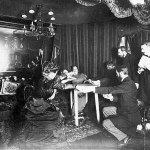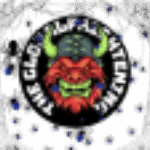In the loneliest corner of the Andean highlands of Bolivia and Peru, an Aymaran legend of the Anchanchu or the Abchanchu is said to lurk. Disguised as an elderly man, weary from his travels, he uses people’s goodness to attack and drink their blood.
Come in, come abchanchu, do not do any harm, because Mallcu protects me.
– Chant to keep the monsters at bay
South America is no stranger to terrifying folklore — from weeping women haunting riverbanks to spectral riders in the dead of night their ancient and distinct cultures throughout history has given rise to so many different legends and myths.
One of the more obscure and perhaps not so well known tales chills the blood quite like that of Anchanchu, sometimes known as the Abchanchu, one of Bolivia’s most enduring and sinister legends. For generations, whispers of this deceptive creature have echoed through mountain villages and remote country paths, warning travelers of the horrors that may lurk beneath a frail, human guise.


The Legend of the Bloodthirsty Trickster
At first glance, Anchanchu appears as nothing more than a harmless, elderly man on the side of the road, a hunched figure, weary from travel, moving slowly along the dusty Bolivian roads. His face is lined with age, his clothes tattered from long journeys, and he leans heavily on a walking stick, luring in his unsuspecting victims.
But behind those sorrowful eyes lies a predator.
Anchanchu is a vampire of ancient origin, known for his ability to shapeshift into this deceptive, vulnerable form.
When a kind-hearted passerby offers to assist the seemingly feeble traveler, walking him to safety or providing shelter for the night when he knocks on your door, it’s then that his true, monstrous nature is revealed. The helpless elder transforms into a savage creature, attacking his victim under the cover of darkness and drinking their blood.
Sometimes he lures the victims to his home, promising them a hot meal or anything to get them inside. Other times he plays on your good will, and you bring him home and give a bed for the night. Even if you survive the attack, you will slowly die of the disease the monster leaves you with.
In some versions of the tale, it’s said the vampire leaves little trace of his victims, allowing him to wander from town to town, his terrible secret forever cloaked by his kindly, unassuming appearance.
A Cautionary Tale Born from Bolivia’s Mountains
The legend of Anchanchu is believed to have originated in Bolivia’s Andean highlands, where treacherous mountain paths wind between isolated villages. It is believed that the vampire story comes from an older demon lore of the modern Aymara people in Bolivia and Peru.


In these remote regions, travelers would often rely on the kindness of strangers for survival — a fact that the myth of Anchanchu turns tragically on its head. It used to be confined to small regions until the 18th century, when tales of the monster travelled further.


In the Uyuni region, he comes with the cold, and if you don’t remember to close the windows and lock your doors, he will just walk right in.


For the people of Huancané, it is recommended to not walk at night, specifically after midnight. Anchanchu appears as a red dog around one to three A.M. His appearance is described as being a pudgy, bald, older man.
If you find yourself on a deserted Bolivian road as the sun begins to set, and you happen upon a frail old man limping along the path, remember the warnings of generations past. His weathered smile and pleading eyes may mask ancient hunger, and one act of misplaced kindness could be your last.
Anchanchu or the Abchanchu waits for the charitable, hiding his fangs behind a trembling voice — and the mountains have many lonely places where the missing are never found.
Newest Posts
-

Anchanchu: The Shapeshifting Vampire of Bolivia’s Lonely Roads
In the loneliest corner of the Andean highlands of Bolivia and Peru, an Aymaran legend of the Anchanchu or the Abchanchu is said to lurk. Disguised as an elderly man, weary from his travels, he uses people’s goodness to attack and drink their blood.
-

The Legend of the Jiāngshī: China’s Hopping Vampire
With stiff limbs after rigor mortis has set in, the Chinese vampire entity, the Jiāngshī is after the life force of the living. But where did the lore of the hopping undead really come from?
-

The Knocking Ghost of Utengasse 47: Basel’s Poltergeist Case
In a small apartment at Utengasse 47 in Basel, a poltergeist was said to torment the family living there. It got so bad and they found no solution that the family had to vacate the place instead.
-

Spiritism and the Religion of Spirit Communication
Spiritism or Kardecism is a philosophy and religion of spirit communication. After being inspired by the Spiritualist movement, the French Allan Kardec developed the loose movement of seances, mediums and communicating with the dead into something people still practice today.
-

Spiritualism and the Occult: Automatic Writing and When Ghosts Slide Into Your DMs
In the height of the spiritualism movement of séances, mediums and table turning, automatic writing was a popular way to communicate with the dead. But what type of writing and messages did the practice leave us with?
-

Table Turning: When Spirits Spill the Tea Through Furniture
One of the earliest ways of communicating with the dead in the modern era was through Table Turning or Table Tipping. For many it was nothing more than a fun parlor trick and game, but for others it became a lifestyle and the foundation of a new spiritual movement.
-

The Dark Origins of the Ouija Board: A Mysterious History of Spirit Communication
The Ouija Board has a long and winded history that has created its own lore and rules. What is really the truth behind the board, where spiritualism meets consumerism?
-

The Ouija Board Murder in Buffalo
Many horrible things have been blamed on the Ouija Board over the years. One of the most famous cases was the murder often named The Ouija Board Murder in Buffalo were a woman in Buffalo was killed after the Ouija Board pointed her out in a mission for revenge.
-

The Spiritualist Movement: The Fox Sisters Who Started a Ghostly Revolution as a Prank
It’s impossible talking about communicating with the dead without talking about The Fox Sisters and their impact they had on the Spiritualism movement as well the enduring popularity ghosts and the afterlife have on people, even when its well known fraudsters performing.
-

The Demon Zozo: The Mysterious and Terrifying Entity of the Ouija Board
A collective memory of people summoning an entity called Zozo has taken over the Ouija Board sessions. The demon who goes by many names is said to be conjured from the human mind, but there are still those claiming that the demon Zozo is something real to fear.
-

The Philip Experiment: The Spirit Created by Scientists
Spiritism September: After a long experiment, a made up spirit started to haunt a group’s seances. What really happened during the Philip experiment, and what does it tell us about what lengths humans go to believe in ghosts?
-

Spiritualism and the Occult: The History of Ectoplasm and Gooey Ghosts
Spiritism September: Ectoplasm was a substance said to be the materialization of spirits in our world. The fascinating ectoplasm gave some insane pictures from seances and plenty of bonkers debunking of fraudulent mediums using it.
References:
Abchanchu: Bolivian Vampire. From the desk of The Reddest Raven | by Rayven Red | Feb, 2025 | Medium
Anchanchu. Dios del mal aymara.




